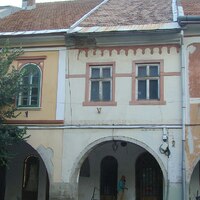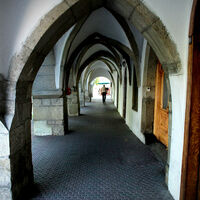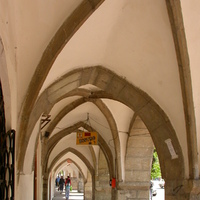Town square in Romania
Type:
Cities,
Secular architecture
Date:
Fifteenth to sixteenth centuries
Location or Findspot (Modern-Day Country):
Romania
Description:
Bistriţa (Bistritsa), in Romania, was founded in the thirteenth century by settlers from German lands. Its location on a river made it a flourishing trading town, and in 1353 the Hungarian king gave it permission to hold a two-week trade fair and have a civic seal; later it was allowed to have a wall and defensive towers. Its surviving town square (with a parish church at the center) contains thirteen houses of the fifteenth and sixteenth centuries connected by spacious rib-vaulted galleries on the ground floor.
The grain market and the annual fair took place under the arches on the north side of the square (still well preserved), giving the name "Corn Market" (Sugălete) to the whole ensemble. The butchers, tanners, and furriers' markets were originally on the south side. On the east were shoemakers' and carpenters' stalls, and on the west carpenters and a school building cited in a document of 1388. The houses preserved in Bistriţa are typical of late medieval urban residences, with living quarters above commercial activities.
The grain market and the annual fair took place under the arches on the north side of the square (still well preserved), giving the name "Corn Market" (Sugălete) to the whole ensemble. The butchers, tanners, and furriers' markets were originally on the south side. On the east were shoemakers' and carpenters' stalls, and on the west carpenters and a school building cited in a document of 1388. The houses preserved in Bistriţa are typical of late medieval urban residences, with living quarters above commercial activities.
Relevant Textbook Chapter(s):
11
Image Credits:
Flickr; Wikimedia Commons






